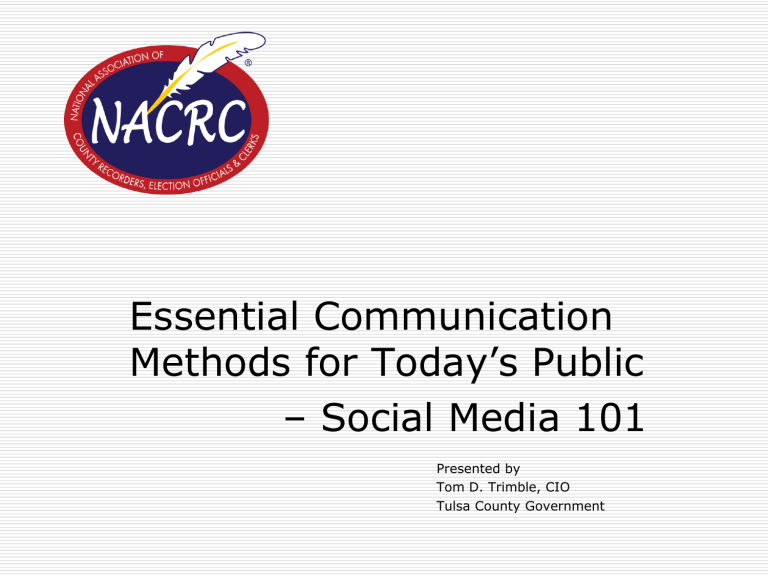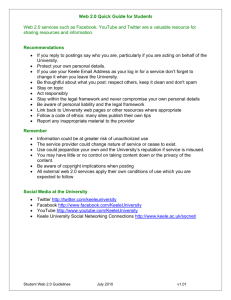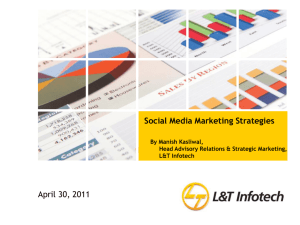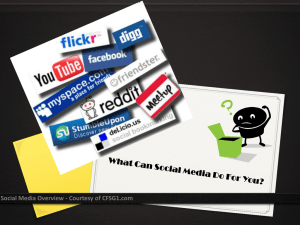Slide 1

Essential Communication
Methods for Today’s Public
– Social Media 101
Presented by
Tom D. Trimble, CIO
Tulsa County Government
What you will learn today
Why Social Media is important to you
Today’s Social Toolset
Understanding social trends
Communicating with today’s public
Benefits of launching a social media strategy
First understand branding
Don’t feel threatened of being exposed
Blaze a trail for others to follow
What will not be covered:
This is not (NOT) a session to encourage or endorse employee use of social media in the workplace.
This is not (NOT) a session to suggest changing your existing social media policies. …Although… If you don’t already have a policy, you should.
Proper policy controls message content and delivery.
Lessons in Leadership
Be open to new ideas
Tech Company, Finland – 2008
Recognize that you are not the first to consider using online media to communicate with your constituents.
http://www.youtube.com/watch?v=hO8Mw
BZl-Vc
Why Social Media?
Two-way communication
Large target audience
Build relationships
Correct misinformation
Spot opportunities and problems
Supporting advocates
Be relevant
It is happening with or without you
Examples of global impact
U.S. Earthquakes during 2011 reported within seconds on Twitter before news stations had the story
Information in Middle East shifting opinions of younger generations
High-speed train wreck – July 2011
Chinese Government vs. onsite witnesses with cameras and Twitter
The Marketing Shift
Away from media and toward direct interaction
From ‘marketing to’ to ‘marketing with’
Understand what is going on
Influence your organization’s future using online social media tools
Today’s Preferred
Levels of Communication
1. Twitter
2. Facebook Status
3. Facebook Messaging
4. E-mail
5. Text Messaging
6. Instant Messaging
7. Memo / Letter
8. Phone
9. Video Chat
10.Face to Face Communication
Benefits:
Control the message to your constituents
Improve perception from the public
Develop constant communication
If you are not sharing your message online, someone else will do it for you
Receive meaningful feedback
Only 2 in 5 Americans today read the paper
The next generation of worker prefers to get their information online
Social Media is Free (only costs time)
Develop a Social Media Plan
Use the P.O.S.T method:
P – People – Who are you trying to engage?
O – Objectives – What are you trying to achieve?
S – Strategies – What will it look like when done?
T – Technologies – What tools will you use?
How to get started
Establish policy on use
Set goals
Prepare for an online presence
Create accounts on Twitter, LinkedIn, and Facebook
Include photo/logo, links to website, content
Create a Page on Facebook
Facebook walks you through the process
Facebook Communications
There are four ways people can interact on your
Facebook Page that you should monitor
Wall Posts
Comments
Likes
News Feeds
Create a cause and add it to your page
Add your blog’s feed to your fan page
Add your events to your Facebook fan page
Ask your Facebook fans a question and participate in the conversation
Use Facebook Insights to get activity and demographic data
Blogs
32% of Fortune 100 companies use blogs
Immediately tell your own story
Know the rules of the game
Share and create great content
Listen and Care
must engage public
Use people, not company logo, for a personal touch
Give
Speak using audiences language
Be transparent
Be consistent
Be Yourself
Blogs are not about trying to be cool
The Weekly Blog
Commit to one post per week
Keep it to no more than a one hour effort:
Research topic – 10 minutes
Write 400-500 words – 40 minutes
Use one photo – 5 minutes
Post to blog site – 5 minutes
Be consistent on the post date (for example, every Tuesday)
Post in the morning
Blogosphere
Read other similar blogs
Comment on other blogs
Follow those who follow you
Build relationships
Be aware of what others say about you
Blog content can be more important than news coverage
Blog location matters
Use a provider like wordpress.org for a more professional site
Bloggers can tell the difference
Create a professional image
Tools like Google Blogs can help you find articles online
Twitter (microblogging)
Optimize your account
Create a custom Twitter background that reflects your organization’s mission or brand
List the Twitter handle of anyone contributing to your organization’s feed
Create a Twitter list of your organizations staff, partners, or supporters
Use Twitterholic.com to connect with the top tweeters in your county
Monitor hashtags for relevant information
(#chs #nyc #dc)
Tracking Tweets -
#TulsaCounty
Relevant questions about you
Relevant questions about government
Requests for support
Complaints and feedback
Praise
Competitor Mentions
Tweets limited to 140 characters
Twitter Usage
Recruit new staff and volunteers via Twitter
Build real relationships by replying, retweeting and joining discussions
Make your tweets retweetable
Monitor your organization’s name on search.twitter.com
Piggyback on Twitter’s trending topics if related to your cause
Promote an event, campaign, movement with twitter hashtags (#beatcancer
#memorywalk)
The business version of Facebook minus the games
Professional networking site
Showcases expertise
Request information
Give advice
Group discussions
Link back to website, blog content, etc. whenever possible
Monitor LinkedIn Statistics
: Best Practices
Next: YouTube
YouTube
Think of YouTube as a public service announcement
A powerful tool to spread your message
Use as a guide or ‘how to’
Link content back to blog, website,
Facebook, etc.
Create short content that can be used again annually
Content
Make interesting or compelling video, not sad or negative
Funny videos tend to get more airplay
Use the YouTube Nonprofit Program for advocacy
Consider partnering with a local nonprofit to help get their message out
Next: Best Practices
Social Media Best Practices
10 minute maintenance – listen
Check Twitter for chatter about your company – 3 minutes
Scan Google News and Blogs Alerts for important articles – 2 minutes
Filter and flag relevant industry-related
LinkedIn questions – 3 minutes
Log in to Facebook and scan your wall and comments – 2 minutes
Social Media Best Practices
20 minute routine – engage
Add content and current events
Answer questions
Build good-will
Respond to relevant blog articles
Thank those posting positive tweets
Handle negative feedback quickly and turn them into your best advocates
Next: Case Study
Case Study - Consider Barack
Obama’s Social Media Plan
More than 5 million supporters across all social networking sites
Utilized 15 different social networks
3.3 million friends
More than 500 groups
300+ applications
A centralized database of every invested voter
2,379,102 supporters via Facebook
Source: http://www.viralblog.com/social-media/case-study-the-full-barackobama-strategy/
Case Study - Consider Barack
Obama’s Social Media Plan
YouTube
139,000 different Obama related clips
1,800 official clips uploaded
More than 14.7 million hours of Obama clips have been viewed
‘Yes We Can’ Music Video viewed more than 14.2 million times
15 Obama videos viewed more than 1 million times
Source: http://www.viralblog.com/social-media/case-study-the-full-barack-obamastrategy/
Case Study - Consider Barack
Obama’s Social Media Plan
Follows 145,836
141,044 followers
263 updates
The Obama Blog
Creates an image of expertise when properly executed
Source: http://www.viralblog.com/social-media/case-study-the-full-barack-obamastrategy/
Case Study - Consider Barack
Obama’s Social Media Plan
Built a Vested Audience
3 million online donors
6.5 million online donations adding up to more than 500 million
Of the 6.5 million donations, 6 million were in amounts of $100.00 or less
The average online donation was $80.00 and gave more than once.
Next: Closing Summary
Source: http://www.viralblog.com/social-media/case-study-the-full-barack-obamastrategy/
Guarantee Online Success for
Your Organization
80% of success online is simply participation
Build a presence and treat it as a extension of yourself – Build Trust
Promote your social media channels via websites, e-mails, footers, etc.
You will get out of social media what you put into it
Use staff familiar with the technology for optimal results
Have fun!




